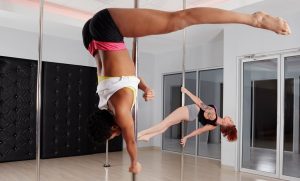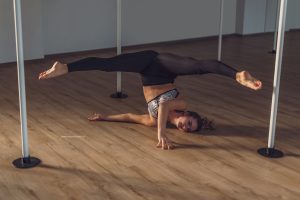Which tube to choose for the home?

The day has come!
You decided to order a tube for home!
But what to pay attention to when choosing the one and only one?
1. Coating
Even 10 years ago, there was one type of tube - chrome and no other choice. It was a torment for people like me, that is, those who have quite dry skin and "do not keep the skin sweating" throughout the training - the skin "dries up" quickly, and sticking to chrome is almost non-existent, so training is not always was satisfactory due to the lack of grip.
There are currently 3 most popular tube coatings:
- stainless steel , i.e. silver tubes, basically standard in pole dance schools and competitions. In order to stick to it, you need to have a well-warmed body, and a "slight sweating" of the skin is welcome. It does not contain nickel or chromium, making it suitable for people with allergies.
- powder coated , i.e. all the colored tubes you have seen (a large selection of colors from the RAL palette). Color can add a cool design to your interior, how to choose shoes for a purse or vice versa: P is much more grippy than stainless, but beware - with drops (i.e. controlled slips) it can burn your skin. This material is great when it comes to learning figures where grip is important, i.e. figures where you only hold onto a piece of the body - on this tube it will be much easier to make this figure than on a stainless one. As for my skin and its dryness - I love it especially in winter, when the air dries me even more, and I will do anything on it!
- brass , i.e. a brass pipe. When it comes to adhesion, it is between stainless and powder coated, which is the perfect compromise. Maintaining it is a bit heavier - this type of tube should be kept warm all the time, otherwise it may lose its beautiful golden color. These tubes are very popular in Australia, where the temperature in summer is high, while in winter (between 10 and 15 degrees) the halls are not heated and in fact the coating comes off the tube. During my six-month stay in Sydney, I conducted classes and did my trainings on brassach - excellent grip, but with longer training, hot tube and sticky body, the tube may chafe the skin, but certainly not as much as powder coated.
Other tubular coatings include chrome, which, according to the opinion, is less adhesive than stainless steel, and silicone, which covers the tube - silicone can be (or should?) Be practiced in clothes.
2. Diameter
I remember 10 years ago I signed up for my first pole dance class in Warsaw. Access to professional tubing was limited and you know what I practiced? On Leroy Merlin tubes: D whose diameter is ... 50mm. If you are a Pole Dance Dinosaur, you know what I'm talking about. If not, it is a diameter that does not necessarily work well, especially with smaller hands. It was hard to hug her, some spins were a torment and stress about whether I would fly out of the tube, because my hand would let go ... But then no one complained about the thickness of the tubes, because there were simply no others!
Currently, we have great comfort, there are sizes that are perfect for our hands and do not cause great discomfort, holding the tube under the knee.
The two most popular thicknesses are 42mm and 45mm , although the current trend among schools (especially new ones) is shifting to smaller diameters where the grip of the tube is easier and more secure.
3. Assembly
Strut or ceiling mounting?
Here you need to think about it:
- Choose a strut if you rent a flat / you do not have a drill / you do not have a peasant who will drill holes in the ceiling / you have a small apartment and a pipe will be disturbing on a daily basis / you often have guests who do not know about your passion and you would prefer to stay that way low flat (up to 2.7 m) / you are sure that the pipe will be stretched and installed correctly !!
- Choose a fixed installation to the ceiling , if you care about the safety of exercises / you have a high ceiling (above 2.7) / you have a drill and a peasant who will drill pipes / you do not care about "cleaning" the pipe after each training
Personally, I recommend mounting to the ceiling - it's always the safer option! Even if you rent a flat, you can fill the holes after assembly (when you move out) and paint over (or hire your / someone else's peasant for this)
4. The height of the room
It is best to measure the height of the room with a laser (one can be purchased in DIY stores) in the place where you plan to place the tube (the height may be different in different places in the same room). If you are not planning to buy a laser, then you must measure with a tape measure - hire a peasant (preferably a technical one) for this, in case of whom to blame for inaccurate measurement; )

